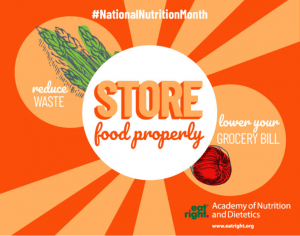 One of the key messages during this year’s National Nutrition Month “Go Further with Food” theme involves proper food storage. So much food is wasted each year because it is not stored and handled properly, resulting in spoilage. You can make your food, from fresh fruits and veggies to leftovers, last longer – thereby reducing food waste and saving you money – by following a few simple tips.
One of the key messages during this year’s National Nutrition Month “Go Further with Food” theme involves proper food storage. So much food is wasted each year because it is not stored and handled properly, resulting in spoilage. You can make your food, from fresh fruits and veggies to leftovers, last longer – thereby reducing food waste and saving you money – by following a few simple tips.
In the Refrigerator
Refrigerated storage is not for the long-term, especially for fresh or cooked foods. The basic rule of thumb for food safety is a maximum of 5 days in the refrigerator. After that, there is a risk of spoilage and cross-contamination by microorganisms. Things such as condiments, pickles, olives, butter, and other similar items can be stored in the refrigerator for longer periods. (Check this useful resource for a more comprehensive list of storage times for different foods.)
The optimal temperature range for your refrigerator is 37-39 degrees Fahrenheit.
In the Freezer
Freezer storage can keep foods fresh for a longer period of time, but it is not indefinite. After 6 months, most frozen foods will suffer from a severe loss of quality. While frozen storage will keep microorganisms at bay, improperly wrapping food before freezing can result in freezer burn. Freezer burn does not mean the food is unsafe to eat, but the flavor and texture may be negatively affected.
The optimal temperature for your freezer is 0 degrees Fahrenheit.
Types of Packaging
Proper food storage depends very much on the type of packing used to store food. Whether being stored in the refrigerator or the freezer, it is best to store food in air tight containers. Plastic or glass containers with tight-fitting lids are the best choice. Heavy duty plastic zipper bags or heavy paper meant for freezer use are also acceptable. Non-zipper sandwich bags, wax paper, aluminum foil, and plastic wrap are not good choices. These materials do not form a tight enough seal to keep food fresh and should not be used by themselves for food storage.
Related article: Strategies for Reducing Food Waste
 0
0
